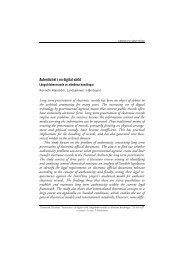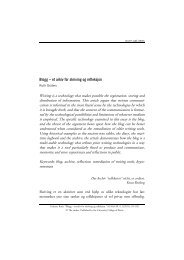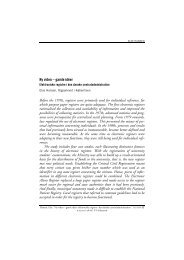The Challenge of Managing Affordances in Computer Game Play
The Challenge of Managing Affordances in Computer Game Play
The Challenge of Managing Affordances in Computer Game Play
You also want an ePaper? Increase the reach of your titles
YUMPU automatically turns print PDFs into web optimized ePapers that Google loves.
HUMAN IT REFEREED SECTION<br />
special k<strong>in</strong>d <strong>of</strong> detached objects that are graspable, portable, and manipulable.<br />
Gibson po<strong>in</strong>ted out that we are constantly grasp<strong>in</strong>g objects and<br />
that they are perceived <strong>in</strong> relation to the hands, and also that “the perception<br />
is constra<strong>in</strong>ed by manipulation, and the manipulation is constra<strong>in</strong>ed<br />
by perception” (224). As we (temporarily) attach a tool to our<br />
body, we extend our capacity <strong>of</strong> perceiv<strong>in</strong>g and act<strong>in</strong>g. <strong>The</strong> capacity to<br />
attach someth<strong>in</strong>g to the body suggests, <strong>in</strong> Gibson’s view, that the boundary<br />
between us and our environment is not fixed at the surface <strong>of</strong> our<br />
bodies.<br />
Consider<strong>in</strong>g that affordances are <strong>in</strong>variant, it implies they are also <strong>in</strong>dependent<br />
<strong>of</strong> cultural and social conventions. Gibson did, however, recognise<br />
that our use <strong>of</strong> objects is affected by “second-hand knowledge”<br />
(or mediated or <strong>in</strong>direct knowledge). As Gibson says, “wisdom is handed<br />
down […] this knowledge is communicated to the child” (1986, 260). A<br />
well-known example is the postbox that <strong>in</strong>vites letter-mail<strong>in</strong>g – an object<br />
that everyone “above the age <strong>of</strong> six knows what it is for” (139). However,<br />
despite mention<strong>in</strong>g second-hand knowledge, it seems Gibson left sociocultural<br />
aspects ma<strong>in</strong>ly unattended. We will return to this issue later.<br />
To see how the affordance concept applies to computer games, we use<br />
a scene from Escape from Monkey Island (EfMI), PC version (2000). In<br />
Figure 1 below, we see how the player, <strong>in</strong> the form <strong>of</strong> the avatar Guybrush<br />
Threepwood, has entered a room through a w<strong>in</strong>dow (at the far end<br />
<strong>of</strong> the room, to the avatar’s right) to pick up th<strong>in</strong>gs she needs. She is now<br />
about to leave the room, and explores whether she can use the door (<strong>in</strong><br />
front <strong>of</strong> the avatar) <strong>in</strong>stead <strong>of</strong> climb<strong>in</strong>g back out through the same w<strong>in</strong>dow<br />
from which she came. When she gets to the door, however, she soon<br />
f<strong>in</strong>ds out that she cannot pass through. We will use this same scene<br />
throughout the discussion <strong>of</strong> different uses <strong>of</strong> affordance.<br />
88









